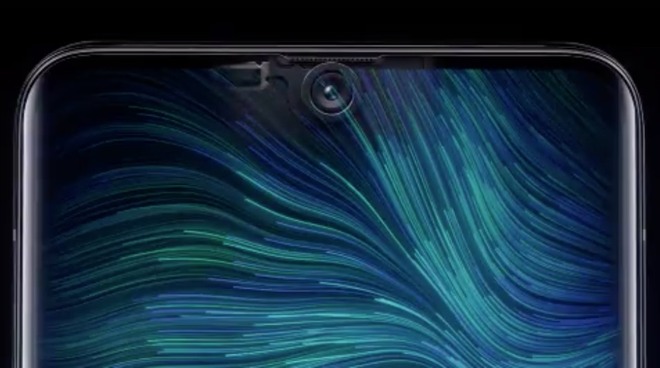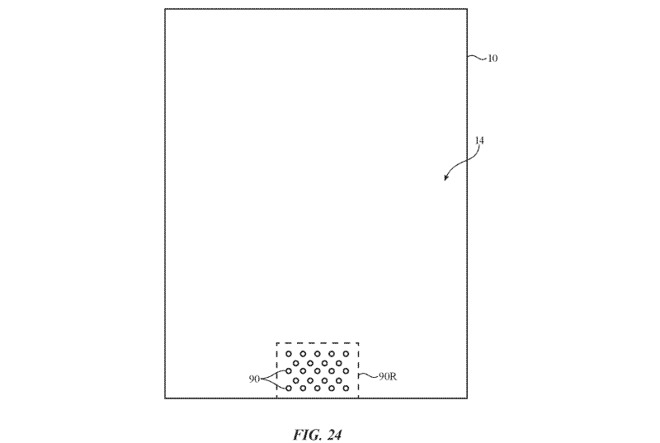A future iPhone could lose the notch with light transmitting windows in the screen
A future version of the iPhone could eliminate the controversial notch from the top of the screen, with Apple hiding sensors behind the display itself and allowing them to function via the use of 'light transmitting windows.'

Oppo's envisioning of its Under Screen Camera
The notch has become the defining feature of the iPhone lineup since the iPhone X, with it being a solution to the problem of keeping components that need external access functional while simultaneously maximizing the amount of display at the front of the device. The design choice quickly led to other smartphone vendors imitating Apple's concept with their own takes, while others produced alternative solutions to the problem.
If a patent granted to Apple from the U.S. Patent and Trademark Office on Tuesday is put into practice, one titled "Display with light transmitting windows," there could possibly be no notch or even a sign of a sensor at all in the future.
In the patent, Apple suggests the use of thin-film circuitry on a substrate for the creation of an OLED panel, with anode and cathode layers used to form pixel circuits. This is effectively a similar technique to how some displays operate, namely applying a current to OLED pixels that can illuminate.
Apple proposes an array of electrical components could be mounted under the substrate, such as light or proximity sensors, which are normally mounted in a somewhat more visible fashion. An array of corresponding "light transmitting windows" can be formed in the substrate to allow sensors to see the outside world, but behind the thin-film pixel circuits.
As the circuitry could interfere with the operation of the sensors, the design of the thin-film circuit and the windows must be produced with care, to minimize obstruction. The positioning can be such that the surrounding pixels could overlap the window areas, effectively hiding them from view externally.

A laser could be used to produce the window sections in a display
It is suggested the windows could be produced to be more transparent than other portions of the display, allowing the sensors to work more optimally while still providing some utility for that area of the screen.
Each window will allow light to pass through the screen to the sensors, though there could be the use of anti-reflection layers internally to prevent emitted light from the OLED layer from immediately bouncing back at the sensors.
Apple goes on to suggest a variety of different ways the cathode layers could be deposited on a display, such as with vertical and horizontal mask elements, lift-off techniques to create the windows, and shadow masks. Laser processing systems are also suggested as a way to create the windows.
Apple files numerous patents and applications with the USPTO on a weekly basis, but while it does show areas of interest for Apple's research and development efforts, it isn't a guarantee that the concepts will make their way into a future product or service.
This isn't Apple's first attempt at the idea, with one 2009 filing suggesting the use of a camera that could be mounted in the middle of a screen behind the display layer, dimming the screen in the important area when a photo is to be taken. Such a concept would eliminate the eye line issue of FaceTime where callers appear to look at the other participant's forehead, something Apple has attempted to solve in software.

One image suggests the technique could be used for Touch ID
A similar idea has also cropped up with the use of pinhole-sized sensors in one May 2019 patent application, which would allow the use of Touch ID on a display without requiring a visible fingerprint reader. Part of today's filing includes an image that could broadly be used for Touch ID purposes, again with sensors behind the display and invisible at a casual glance.
The idea of a behind-the-screen sensor array has also been explored by other companies. In June, Oppo revealed its Under Screen Camera, which uses a custom pixel architecture to allow light to pass through to the sensor, with glare and color tint issues fixed in software.
As for future iPhone models, it has been suggested Apple could reduce the TrueDepth notch size in the 2020 releases, before removing it completely by 2021.

Oppo's envisioning of its Under Screen Camera
The notch has become the defining feature of the iPhone lineup since the iPhone X, with it being a solution to the problem of keeping components that need external access functional while simultaneously maximizing the amount of display at the front of the device. The design choice quickly led to other smartphone vendors imitating Apple's concept with their own takes, while others produced alternative solutions to the problem.
If a patent granted to Apple from the U.S. Patent and Trademark Office on Tuesday is put into practice, one titled "Display with light transmitting windows," there could possibly be no notch or even a sign of a sensor at all in the future.
In the patent, Apple suggests the use of thin-film circuitry on a substrate for the creation of an OLED panel, with anode and cathode layers used to form pixel circuits. This is effectively a similar technique to how some displays operate, namely applying a current to OLED pixels that can illuminate.
Apple proposes an array of electrical components could be mounted under the substrate, such as light or proximity sensors, which are normally mounted in a somewhat more visible fashion. An array of corresponding "light transmitting windows" can be formed in the substrate to allow sensors to see the outside world, but behind the thin-film pixel circuits.
As the circuitry could interfere with the operation of the sensors, the design of the thin-film circuit and the windows must be produced with care, to minimize obstruction. The positioning can be such that the surrounding pixels could overlap the window areas, effectively hiding them from view externally.

A laser could be used to produce the window sections in a display
It is suggested the windows could be produced to be more transparent than other portions of the display, allowing the sensors to work more optimally while still providing some utility for that area of the screen.
Each window will allow light to pass through the screen to the sensors, though there could be the use of anti-reflection layers internally to prevent emitted light from the OLED layer from immediately bouncing back at the sensors.
Apple goes on to suggest a variety of different ways the cathode layers could be deposited on a display, such as with vertical and horizontal mask elements, lift-off techniques to create the windows, and shadow masks. Laser processing systems are also suggested as a way to create the windows.
Apple files numerous patents and applications with the USPTO on a weekly basis, but while it does show areas of interest for Apple's research and development efforts, it isn't a guarantee that the concepts will make their way into a future product or service.
This isn't Apple's first attempt at the idea, with one 2009 filing suggesting the use of a camera that could be mounted in the middle of a screen behind the display layer, dimming the screen in the important area when a photo is to be taken. Such a concept would eliminate the eye line issue of FaceTime where callers appear to look at the other participant's forehead, something Apple has attempted to solve in software.

One image suggests the technique could be used for Touch ID
A similar idea has also cropped up with the use of pinhole-sized sensors in one May 2019 patent application, which would allow the use of Touch ID on a display without requiring a visible fingerprint reader. Part of today's filing includes an image that could broadly be used for Touch ID purposes, again with sensors behind the display and invisible at a casual glance.
The idea of a behind-the-screen sensor array has also been explored by other companies. In June, Oppo revealed its Under Screen Camera, which uses a custom pixel architecture to allow light to pass through to the sensor, with glare and color tint issues fixed in software.
As for future iPhone models, it has been suggested Apple could reduce the TrueDepth notch size in the 2020 releases, before removing it completely by 2021.

Comments
Rinse.
Repeat.
What makes me laugh every time is the fact iKnockoff users claimed Apple copied Essential Phones camera hole to invent the notch and FaceID. Yet when Samsung releases a camera hole the definition of notch changes and suddenly Samsungs knockoffs are "notch-less". The hypocrisy is deep with even Samsung ads claiming their knockoffs are "notch-less". Really shows how stupid iKnockoff users are.
The video in the article has been removed.
I bet it was Samsungs ads mocking the notch.
Humans want to look each other in the eyes, not in the mouths.
People who are attracted to you tend to look at your mouth more often. There's nothing "perverse" about that. America has demonized people liking each other. It's natural, nothing wrong with it.
Excerpt: Cook, speaking at an investor conference hosted by Goldman Sachs in San Francisco today, called the color saturation of OLED (organic light-emitting diode) displays "awful." "If you ever buy anything online and really want to know what he color is, as many people do, you should really think twice before you depend on the color from an OLED display," Cook said.
How 'bout NFC? http://allthingsd.com/20120912/interview-phil-schiller-on-why-the-iphone-5-has-a-new-connector-but-not-nfc-or-wireless-charging/
Excerpt: "In an interview, Apple Senior VP Phil Schiller said that Passbook alone does what most customers want and works without existing merchant payment systems. It’s not clear that NFC is the solution to any current problem, Schiller said. “Passbook does the kinds of things customers need today.”
Here's a bonus from that same article. Schiller downplaying wireless charging. Note his reasoning for why it isn't a good idea:
Excerpt: As for wireless charging, Schiller notes that the wireless charging systems still have to be plugged into the wall, so it’s not clear how much convenience they add. The widely-adopted USB cord, meanwhile, can charge in wall outlets, computers and even on airplanes, he said.
“Having to create another device you have to plug into the wall is actually, for most situations, more complicated,” Schiller said.
Downplayed until adopted.
I can't really follow your 5G logic. It makes no sense at all. Apple hasn't downplayed 5G. Apple just had no access to 5G chips. We all know they're getting 5G chips from Qualcomm. Please don't attribute that "logic" to my reckoning. That's all you bud.
2) You are confused, I made no such “style thief” comment. Reread the comments to un-confuse yourself.